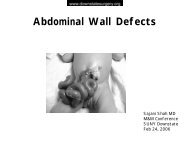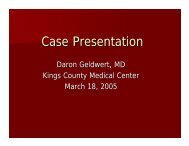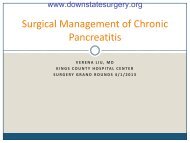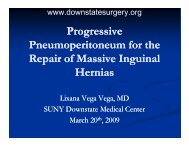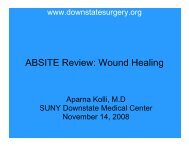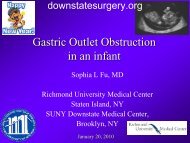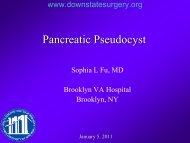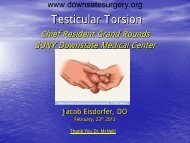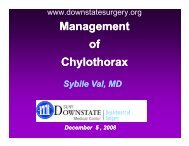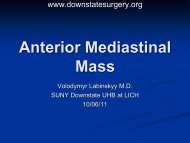Testicular Cancer - Department of Surgery at SUNY Downstate ...
Testicular Cancer - Department of Surgery at SUNY Downstate ...
Testicular Cancer - Department of Surgery at SUNY Downstate ...
Create successful ePaper yourself
Turn your PDF publications into a flip-book with our unique Google optimized e-Paper software.
www.downst<strong>at</strong>esurgery.org<br />
<strong>Testicular</strong> <strong>Cancer</strong><br />
PATRICIA LEUNG<br />
8.22.13<br />
<strong>SUNY</strong> DOWNSTATE MEDICAL CENTER
www.downst<strong>at</strong>esurgery.org<br />
Case Present<strong>at</strong>ion<br />
<br />
<br />
<br />
<br />
<br />
29 year old male<br />
No PMH/PSH<br />
CC: 6 weeks <strong>of</strong> painless swelling left testicle<br />
Denied any trauma, fever/chills, family history<br />
Exam:<br />
HR 70 RR 20 T 97.3 BP 134/79<br />
Left testis enlarged, firm, nontender to palp<strong>at</strong>ion; no<br />
transillumin<strong>at</strong>ion; right testis WNL<br />
No lymphadenop<strong>at</strong>hy
www.downst<strong>at</strong>esurgery.org<br />
<br />
<br />
Labs:<br />
CBC, CMP WNL<br />
β-hCG 30<br />
AFP neg<strong>at</strong>ive<br />
Imaging - Ultrasound:<br />
L testicle - 6.3 x 5.5 x 3.6 cm left testicle almost completely replaced<br />
by a large solid heterogeneous mass measuring approxim<strong>at</strong>ely 5 x 4.5 x<br />
3.1 cm<br />
R testicle - 3.9 x 2.1 x 1.8 cm
www.downst<strong>at</strong>esurgery.org<br />
<br />
<br />
Left radical orchiectomy<br />
P<strong>at</strong>hology:<br />
Seminoma, 6.3 x 5 x4 cm<br />
Tumor limited to testis and epididymis without vascular/lymph<strong>at</strong>ic<br />
invasion; sperm<strong>at</strong>ic cord uninvolved by tumor
Introduction<br />
www.downst<strong>at</strong>esurgery.org<br />
<br />
<strong>Testicular</strong> cancer is most common among men aged 15 to 35 years<br />
Secondary peak in incidence after age 60<br />
Incidence 7.5 cases per 100,000<br />
<br />
<br />
<br />
<br />
5-fold higher in whites<br />
Highly tre<strong>at</strong>able<br />
Mortality r<strong>at</strong>e before 1970s was 50% compared to
www.downst<strong>at</strong>esurgery.org<br />
An<strong>at</strong>omy
www.downst<strong>at</strong>esurgery.org<br />
Differential Diagnosis<br />
<br />
<br />
<br />
<br />
<br />
<br />
<br />
Abdominal hernia<br />
Epididymitis<br />
Hydrocele<br />
Lymphoma<br />
Orchitis<br />
Sperm<strong>at</strong>ocele, varicocele<br />
<strong>Testicular</strong> Torsion
Risk Factors<br />
www.downst<strong>at</strong>esurgery.org<br />
<br />
<br />
<br />
<br />
<br />
<br />
Undescended testis (cryptorchidism) – 4-8 fold increased risk<br />
- Orchiopexy<br />
Genetics – Klinefelter syndrome, Down’s syndrome<br />
Family history <strong>of</strong> testis cancer – 1.4% have family history; risk <strong>of</strong><br />
testicular cancer increases 4-6 fold in sons and siblings<br />
Personal history – 1-2% p<strong>at</strong>ients with testicular cancer will develop a<br />
second primary tumor in contral<strong>at</strong>eral testis<br />
Environment – DES, Agent Orange, solvents<br />
Activities – horseback and motorcycle riding, local trauma, and<br />
increased scrotal temper<strong>at</strong>ure (are not)
www.downst<strong>at</strong>esurgery.org<br />
Types <strong>of</strong> <strong>Testicular</strong> Germ Cell<br />
Tumors<br />
Seminomas (30-60%)<br />
<br />
<br />
<br />
Nonseminomas<br />
- Embryonal carcinomas (3-5%)<br />
- Ter<strong>at</strong>omas (5-10%)<br />
- Yolk sac tumors<br />
- Choriocarcinomas (1%)<br />
- Mixed (60%)<br />
Tumors with a mixture <strong>of</strong> seminoma and nonseminoma components<br />
are managed as nonseminomas<br />
Tumors with seminoma histology but with elev<strong>at</strong>ed serum AFP are<br />
tre<strong>at</strong>ed as nonseminomas
www.downst<strong>at</strong>esurgery.org<br />
Seminoma vs. Nonseminoma<br />
Seminoma<br />
<br />
<br />
<br />
<br />
Less aggressive<br />
Radiosensitive<br />
Diagnosed <strong>at</strong> earlier stage: CS I, II<br />
and III disease is 85%, 10% and 5%<br />
Metast<strong>at</strong>ic seminoma who<br />
experience relapse after<br />
tre<strong>at</strong>ment, 10-15% have NSGCT<br />
elements<br />
Nonseminoma<br />
CS I, II and III is 33%, 33%, 33%<br />
<br />
<br />
Higher incidence <strong>of</strong> occult<br />
metastasis<br />
Higher risk <strong>of</strong> systemic relapse after<br />
tre<strong>at</strong>ment <strong>of</strong> retroperitoneum
www.downst<strong>at</strong>esurgery.org<br />
Diagnosis<br />
<br />
<br />
<br />
<br />
Localized disease<br />
Painless swelling or nodule <strong>of</strong> one testicle<br />
Dull ache or heavy sens<strong>at</strong>ion<br />
Hem<strong>at</strong>oma with trauma<br />
<br />
<br />
<br />
<br />
<br />
<br />
Metast<strong>at</strong>ic disease:<br />
Anorexia, nausea, GI symptoms<br />
Back pain (retroperitoneal disease)<br />
Cough, chest pain, hemoptysis (mediastinal adenop<strong>at</strong>hy or metast<strong>at</strong>ic<br />
lung disease<br />
Gynecomastia (hCG)<br />
Hyperthyroidism (hCG)
www.downst<strong>at</strong>esurgery.org<br />
Serum tumor markers<br />
<br />
<br />
<br />
<br />
Alpha-fetoprotein (AFP) – elev<strong>at</strong>ed in 40-60% <strong>of</strong> men with<br />
nonseminomas; seminomas do not produce AFP<br />
β-hCG – elev<strong>at</strong>ion seen in 14% <strong>of</strong> p<strong>at</strong>ients with stage I seminoma<br />
and 50% <strong>of</strong> p<strong>at</strong>ients with metast<strong>at</strong>ic seminoma; 40-60% <strong>of</strong> men with<br />
nonseminoma have elev<strong>at</strong>ed levels<br />
LDH – elev<strong>at</strong>ed in both but with less clear prognostic significance<br />
Measured before and after surgery
Imaging<br />
www.downst<strong>at</strong>esurgery.org<br />
<br />
<br />
<br />
<br />
<br />
<strong>Testicular</strong> ultrasound – highly specific<br />
CT Abdomen/Pelvis<br />
Chest XR, +/- CT<br />
MRI<br />
PET – no role<br />
JUM July 1, 2007 vol. 26no. 7 981-984<br />
RadioGraphics March 2004 vol. 24 no. 2 387-404
www.downst<strong>at</strong>esurgery.org<br />
Summary <strong>of</strong> initial workup<br />
European Associ<strong>at</strong>ion <strong>of</strong> Urology 2012
Management<br />
www.downst<strong>at</strong>esurgery.org<br />
NO Transscrotal biopsy – risk <strong>of</strong> local dissemin<strong>at</strong>ion <strong>of</strong> tumor into<br />
scrotum<br />
NO Transscrotal approach – increase in risk <strong>of</strong> local recurrence<br />
YES Radical inguinal orchiectomy with division <strong>of</strong> sperm<strong>at</strong>ic cord <strong>at</strong><br />
level <strong>of</strong> internal ring
www.downst<strong>at</strong>esurgery.org<br />
TNM Classific<strong>at</strong>ion<br />
Post-orchiectomy<br />
European Associ<strong>at</strong>ion <strong>of</strong> Urology 2012
www.downst<strong>at</strong>esurgery.org<br />
Retroperitoneal Nodes<br />
<br />
<br />
<br />
<br />
Most common route – to<br />
retroperitoneal lymph nodes<br />
Right sided tumors<br />
Interaortocaval<br />
Precaval and<br />
paracaval nodes<br />
Left sided tumors<br />
Para-aortic and pre-aortic<br />
Interaortocaval<br />
Contral<strong>at</strong>eral spread more<br />
common with right sided<br />
tumors and associ<strong>at</strong>ed with<br />
large volume disease
www.downst<strong>at</strong>esurgery.org
www.downst<strong>at</strong>esurgery.org<br />
Staging<br />
European Associ<strong>at</strong>ion <strong>of</strong> Urology 2012
www.downst<strong>at</strong>esurgery.org<br />
Simplified Staging<br />
<br />
<br />
<br />
<br />
Clinical Stage I<br />
No Radiographic Evidence <strong>of</strong> Metast<strong>at</strong>ic Disease<br />
Elev<strong>at</strong>ed STM<br />
Clinical Stage II<br />
Retroperitoneal Lymphadenop<strong>at</strong>hy<br />
Clinical Stage III<br />
Pulmonary, non-retroperitoneal lymph nodes or visceral metastases<br />
Retroperitoneal nodes with STM levels 2 and 3<br />
NO STAGE IV
www.downst<strong>at</strong>esurgery.org<br />
Post-orchiectomy management<br />
Seminoma
www.downst<strong>at</strong>esurgery.org<br />
Post-orchiectomy management<br />
Seminoma<br />
Stage 1<br />
Surveillance<br />
Adjuvant tre<strong>at</strong>ment with radi<strong>at</strong>ion therapy<br />
Single cycle <strong>of</strong> carbopl<strong>at</strong>in chemotherapy<br />
Disease-specific survival – 99% independent <strong>of</strong> management choice<br />
<br />
<br />
Stage IIA/IIB<br />
Paraaortic and iliac node radi<strong>at</strong>ion therapy<br />
Chemotherapy<br />
Both<br />
Stage IIC/III<br />
<br />
Chemotherapy
www.downst<strong>at</strong>esurgery.org<br />
Post-orchiectomy management<br />
Nonseminoma
www.downst<strong>at</strong>esurgery.org<br />
Post-orchiectomy management<br />
Nonseminoma<br />
<br />
<br />
<br />
Stage I<br />
Surveillance (30% relapse)<br />
Adjuvant chemotherapy<br />
Modified retroperitoneal lymph node dissection<br />
(RPLND)<br />
Stage IIA/IIB<br />
<br />
Bil<strong>at</strong>eral RPLND<br />
Multiagent pl<strong>at</strong>inum-based chemotherapy – overall cure r<strong>at</strong>e <strong>of</strong> 85%<br />
Stage IIC/III<br />
<br />
Chemotherapy
www.downst<strong>at</strong>esurgery.org<br />
Surveillance
Summary<br />
www.downst<strong>at</strong>esurgery.org<br />
<br />
<br />
<br />
<br />
<br />
<br />
<strong>Testicular</strong> cancer is an uncommon but highly tre<strong>at</strong>able cancer<br />
Germ-cell tumors comprise >95% <strong>of</strong> testicular cancers<br />
Tumors with seminoma histology but with elev<strong>at</strong>ed AFP are<br />
considered nonseminomas<br />
Seminomas are radiosensitive and respond well to pl<strong>at</strong>in-based<br />
chemotherapy<br />
Most common route <strong>of</strong> disease dissemin<strong>at</strong>ion is via the lymph<strong>at</strong>ic<br />
channels from the primary tumor to retroperitoneal lymph nodes<br />
Retroperitoneal lymph node dissection is an effective therapy for<br />
p<strong>at</strong>ients with high-risk clinical stage I nonseminom<strong>at</strong>ous germ cell<br />
cancer.
References<br />
www.downst<strong>at</strong>esurgery.org<br />
NCCN Clinical Practice Guidelines in Oncology 2012<br />
European Associ<strong>at</strong>ion <strong>of</strong> Urology: Guidelines on <strong>Testicular</strong> <strong>Cancer</strong> 2012<br />
<br />
<br />
<br />
<br />
<br />
<br />
Campbell-Walsh Urology 10 th edition<br />
Retroperitoneal lymph node dissection in testis cancer, Urology Times: Clinical<br />
Edition June 2009<br />
Evalu<strong>at</strong>ion <strong>of</strong> Lymph Node Counts in Primary Retroperitoneal Lymph Node<br />
Dissection; <strong>Cancer</strong>, Nov 2010<br />
Retroperitoneal lymph node dissection for residual masses after<br />
chemotherapyin nonseminom<strong>at</strong>ous germ cell testicular tumor, World Journal<br />
<strong>of</strong> Surgical Oncology 2010: 8:97<br />
The Role <strong>of</strong> Primary Retroperitoneal Lymph Node Dissection in Clinical Stage I<br />
Nonseminom<strong>at</strong>ous Germ Cell <strong>Testicular</strong> <strong>Cancer</strong>, American Society <strong>of</strong> Clinical<br />
Oncology 2010<br />
Thank you Dr. Mike Tyler and Dr. Brian McNeil



